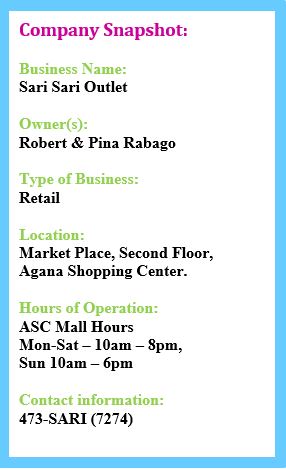By: The CNMI SBDC Staff
 Shenanigans Restaurant is
located in Garapan, Saipan. They are open for breakfast at 7:30am on Saturday
and Sunday only and every day for lunch from 10:30am – 3:00pm and dinner from
5:30pm – 10:00pm. Contact Shenanigans Restaurant at 670-233-8324 or e-mail shenanigans@islandviewers.com.
Shenanigans Restaurant is
located in Garapan, Saipan. They are open for breakfast at 7:30am on Saturday
and Sunday only and every day for lunch from 10:30am – 3:00pm and dinner from
5:30pm – 10:00pm. Contact Shenanigans Restaurant at 670-233-8324 or e-mail shenanigans@islandviewers.com.
Growing up in a
restaurant environment, the exposure to the hotel and restaurant industry from
her grandparents and father, and then later studied the business aspects of the
industry in college, Belen Busby was destined to open a restaurant of her own.
She stated, “It’s kind of a childhood dream that needed to happen.” Belen was
born into the industry where her grandparents owned a restaurant in the
Philippines and then having worked in F&B businesses since the age of 18.
She went to college and earned a degree in Hotel and Restaurant Administration
and a Bachelor’s of Science in Information Technology and Network Engineering.
Belen has resided on Saipan for 21 years with her husband Michael Busby and
son, Rafael.
Five years ago, Belen and
Michael opened Shenanigans Restaurant located in Orchid St. Beach Road, Garapan
serving up pasta, sandwiches, and other delicious entrees. The business was
funded through their personal savings and personal loans. Belen recalls back on
the obstacles they faced during their start-up years that not only affected the
CNMI throughout but their business as well. Shenanigans Restaurant was opened
during a period when the government and private sector were cutting hours,
during the unfortunate and unforeseen disasters in Japan (one of the CNMI’s
main tourism markets), and the increase in prices and utility rates. Other
challenges have been obtaining CNMI-only Transitional Worker (CW) permits for
workers, finding experienced U.S. Citizens to replace CWs, and maintaining
operating capital to meet the shortcoming of the low season. However, the
Busby’s survived and Belen stated that if they could survive those years,
especially in an industry as tough as the restaurant business, she believes
they can survive another five years and more.
As their five year mark
approached, their equipment reached its mark as well. With the guidance and
assistance of the CNMI SBDC, the Commonwealth Development Authority (CDA), and
City Trust Bank, the Busby’s were able to obtain funding to purchase new
equipment and repair their old ones. In addition, they were able to access
additional operating capital and gained the knowledge of creating a formal
financial portfolio for their company. One of the most difficult years for the
Busby’s and Shenanigans Restaurant was the hardships they faced in 2014 and
making it through that served as their most memorable triumph. Belen shared her
gratitude and appreciation of the patronage of their customers and the support
of their vendors and the trust that they have instilled in them over the years.
With her experience Belen
advises entrepreneurs, “Follow your instinct and keep praying for guidance.
Know who to trust and stay away from the ones that project negative vibes.” She
continues on to say that a business is a gamble. You will never know if you are
going to succeed unless you try. It is also a test of self-control and knowing
when to stop. Before Belen and Michael opened Shenanigans, she shared her
possible venture with others. They questioned her decision with the condition
of the economy. However, she responded that [the economy] is in the bottom and
that there is nowhere for it to go but up. She also stated that if she did not
do it now then she might not have the chance to do it again and she will never
know if it failed or succeeded.
 Shenanigans Restaurant is
located in Garapan, Saipan. They are open for breakfast at 7:30am on Saturday
and Sunday only and every day for lunch from 10:30am – 3:00pm and dinner from
5:30pm – 10:00pm. Contact Shenanigans Restaurant at 670-233-8324 or e-mail shenanigans@islandviewers.com.
Shenanigans Restaurant is
located in Garapan, Saipan. They are open for breakfast at 7:30am on Saturday
and Sunday only and every day for lunch from 10:30am – 3:00pm and dinner from
5:30pm – 10:00pm. Contact Shenanigans Restaurant at 670-233-8324 or e-mail shenanigans@islandviewers.com.
For more information on
how the CNMI SBDC can assist you start or expand your business, contact their
office at 670-664-3018 or visit www.pacificsbdc.com.




















.jpg)

.jpg)
.jpg)
.jpg)





